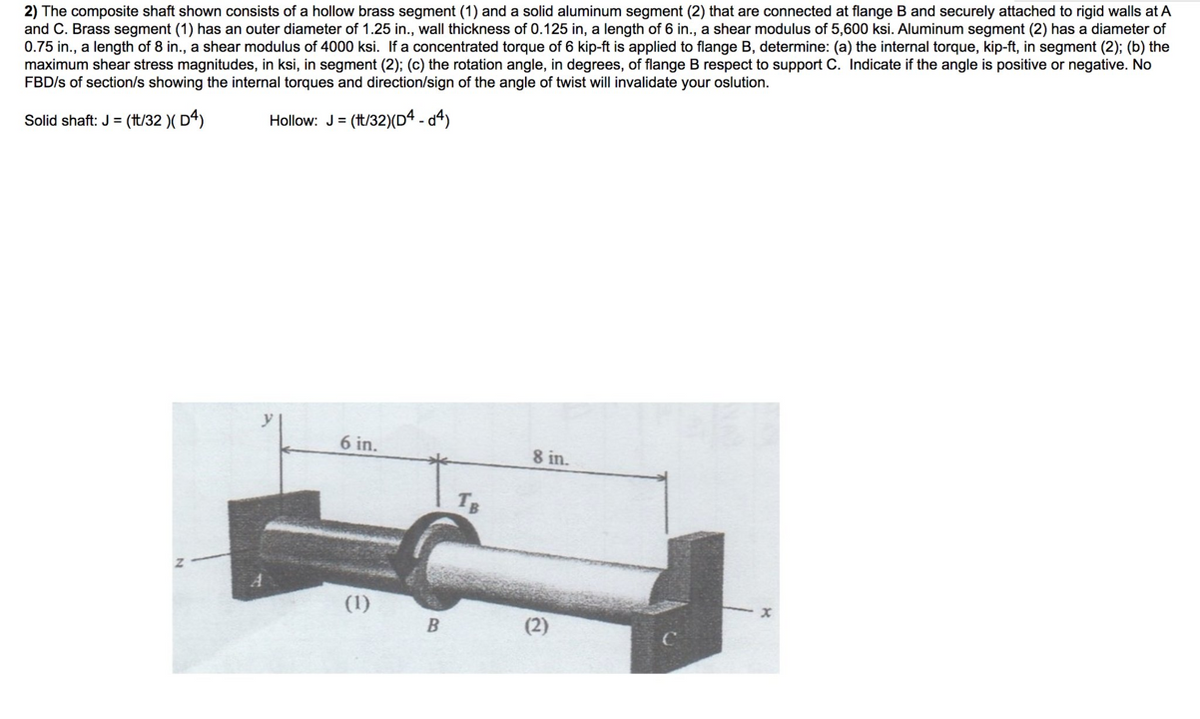2) The composite shaft shown consists of a hollow brass segment (1) and a solid aluminum segment (2) that are connected at flange B and securely attached to rigid walls at A and C. Brass segment (1) has an outer diameter of 1.25 in., wall thickness of 0.125 in, a length of 6 in., a shear modulus of 5,600 ksi. Aluminum segment (2) has a diameter of 0.75 in., a length of 8 in., a shear modulus of 4000 ksi. If a concentrated torque of 6 kip-ft is applied to flange B, determine: (a) the internal torque, kip-ft, in segment (2); (b) the maximum shear stress magnitudes, in ksi, in segment (2); (c) the rotation angle, in degrees, of flange B respect to support C. Indicate if the angle is positive or negative. No FBD/s of section/s showing the internal torques and direction/sign of the angle of twist will invalidate your oslution. Solid shaft: J = (tt/32 )(D4) Hollow: J= (tt/32)(D4-d4) 6 in. (1) B 8 in. (2)
2) The composite shaft shown consists of a hollow brass segment (1) and a solid aluminum segment (2) that are connected at flange B and securely attached to rigid walls at A and C. Brass segment (1) has an outer diameter of 1.25 in., wall thickness of 0.125 in, a length of 6 in., a shear modulus of 5,600 ksi. Aluminum segment (2) has a diameter of 0.75 in., a length of 8 in., a shear modulus of 4000 ksi. If a concentrated torque of 6 kip-ft is applied to flange B, determine: (a) the internal torque, kip-ft, in segment (2); (b) the maximum shear stress magnitudes, in ksi, in segment (2); (c) the rotation angle, in degrees, of flange B respect to support C. Indicate if the angle is positive or negative. No FBD/s of section/s showing the internal torques and direction/sign of the angle of twist will invalidate your oslution. Solid shaft: J = (tt/32 )(D4) Hollow: J= (tt/32)(D4-d4) 6 in. (1) B 8 in. (2)
Materials Science And Engineering Properties
1st Edition
ISBN:9781111988609
Author:Charles Gilmore
Publisher:Charles Gilmore
Chapter12: Composite Materials
Section: Chapter Questions
Problem 12.7P: Estimate the transverse tensile strength of the concrete in Problem 12.6.
Related questions
Question
100%
Please answer ASAP!
STRENGTH OF MATERIALS (Please write the complete solutions and FBD/Free-Body Diagram legibly. No long explanation needed. Rate/Thumbs up will be given. Answer in 3 Decimal Places)

Transcribed Image Text:2) The composite shaft shown consists of a hollow brass segment (1) and a solid aluminum segment (2) that are connected at flange B and securely attached to rigid walls at A
and C. Brass segment (1) has an outer diameter of 1.25 in., wall thickness of 0.125 in, a length of 6 in., a shear modulus of 5,600 ksi. Aluminum segment (2) has a diameter of
0.75 in., a length of 8 in., a shear modulus of 4000 ksi. If a concentrated torque of 6 kip-ft is applied to flange B, determine: (a) the internal torque, kip-ft, in segment (2); (b) the
maximum shear stress magnitudes, in ksi, in segment (2); (c) the rotation angle, in degrees, of flange B respect to support C. Indicate if the angle is positive or negative. No
FBD/s of section/s showing the internal torques and direction/sign of the angle of twist will invalidate your oslution.
Solid shaft: J = (tt/32 )(D4)
Hollow: J= (tt/32)(D4-d4)
6 in.
(1)
B
TB
8 in.
(2)
Expert Solution
This question has been solved!
Explore an expertly crafted, step-by-step solution for a thorough understanding of key concepts.
Step by step
Solved in 3 steps with 2 images

Knowledge Booster
Learn more about
Need a deep-dive on the concept behind this application? Look no further. Learn more about this topic, civil-engineering and related others by exploring similar questions and additional content below.Recommended textbooks for you

Materials Science And Engineering Properties
Civil Engineering
ISBN:
9781111988609
Author:
Charles Gilmore
Publisher:
Cengage Learning

Materials Science And Engineering Properties
Civil Engineering
ISBN:
9781111988609
Author:
Charles Gilmore
Publisher:
Cengage Learning